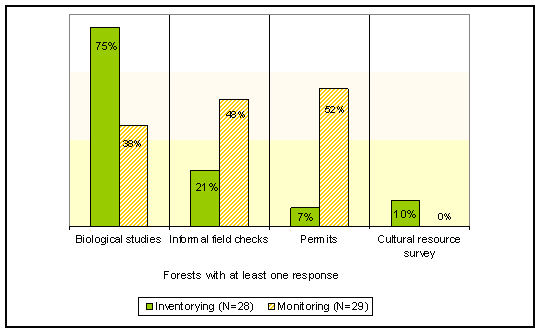In 2003, researchers from the Institute for Culture and Ecology (IFCAE) surveyed national forests across the country to identify barriers and opportunities to nontimber forest product (NTFP) management. What follows is a sample from the full report entitled:
McLain, R.J., Jones, E.T. 200X. Nontimber forest products management on national forests in the United States. Gen. Tech. Rep. PNW-GTR-655. Portland, OR. U.S. Department of Agriculture, Forest Service, Pacific Northwest Research Station. 85 p.
The report is available free of charge from the U.S. Forest Service at www.fs.fed.us/pnw/publications/index.shtml or by calling 503-808-2130.
The survey indicates that NTFP harvesting takes place on national forests in all parts of the United States. Firewood, posts and poles, Christmas trees, transplants, and boughs form the backbone of many NTFP programs (Figure 1). However, a variety of other botanical products, including mushrooms, floral greens, cones, and medicinal plants are also harvested on national forests.
 |
Figure 1 - Products harvested on national forests. |
About half of the national forests that answered the survey reported that they inventory and monitor NTFPs. However, the quality of these programs differs considerably from forest to forest (Figure 2). Many of the national forests indicated that they use unsystematic monitoring techniques, such as visually examining harvest sites and checking to see if harvesters have permits. Although important, these techniques do not provide very accurate information about what levels of harvesting are sustainable. Additionally, most national forests monitored only a small number of products - primarily firewood, posts and poles, and Christmas trees. Again, while this information is useful, it is data on only a small fraction of the NTFPs removed from national forests.
 |
Figure 2 - Methods of NTFP inventory and monitoring. |
Many of the survey respondents stated that harvesters could contribute to NTFP inventory and monitoring. Managers who supported harvester involvement emphasized the knowledge that harvesters have to offer, as well as the fact that harvesters are already out on the ground, as reasons for including them in inventory and monitoring (I&M) programs.
- They could easily describe locations where they are harvesting and make sure it [harvesting] is done in a sustainable manner. They could also inform the FS on situations where over-harvesting by other gatherers is happening.
- Commercial harvesters have knowledge of what species and products are available in the district and the amounts available. This information is valuable for inventorying products. They can provide valuable information on the effectiveness of harvest amounts and methods of promoting long-term viability of species.
Some employees gave examples of how harvesters already contribute to NTFP inventory and monitoring, as well as other management activities.
"A local non-profit group.... has a very strong working relationship with NTFP harvesters. In conversations with this group, they encourage the active participation of harvesters in the monitoring of NTFP populations."
"Sassafras harvesters are able to track supply in areas. Fuelwood harvesters already help clean up timber sale areas and reduce fuel hazards."
However, support for involving harvesters was tempered by concerns about whether the agency has the capacity to manage collaborative inventory and monitoring programs. Some respondents also expressed doubts about the ability of harvesters to do the work in a scientific manner and skepticism as to whether harvesters would be willing to become involved. Survey respondents cited inadequate funding and lack of capacity (i.e., insufficient staff and technical expertise) as the major barriers to more widespread use of NTFP inventory and monitoring (see figure 3).
 |
Figure 3 - Barriers to inventory and monitoring. |
Agency-harvester inventory and monitoring partnerships are emerging in parts of the United States to overcome the difficulties of inadequate funding and staffing for monitoring and inventorying NTFP species. A companion piece to this survey, "Nontimber forest product inventorying and monitoring in the United States: rationale and recommendations for a participatory approach (Lynch and others 2004)," discusses in greater detail the need for agency-harvester inventory and monitoring partnerships (see www.ifcae.org/projects/ncssf1/index.html for a downloadable version of the report). For agency-harvester collaborations to work, inventory and monitoring programs must simultaneously address the needs of harvesters (e.g., safeguards to protect information about site locations and the provision of access guarantees) and the needs of forest management agencies (e.g., data quality control). Effective collaborative NTFP inventory and monitoring systems also require the development of suitable training materials for both harvesters and forest managers, as well as a long-term commitment on the part of upper-level agency administrators to invest resources in such systems. In an effort to help forest managers to collaborate with harvesters as well as other community stakeholders, IFCAE has produced a set of guidelines for participatory biological monitoring (available at www.ifcae.org/pbm/).
By Rebecca McLain and Eric T. Jones, Institute for Culture and Ecology


